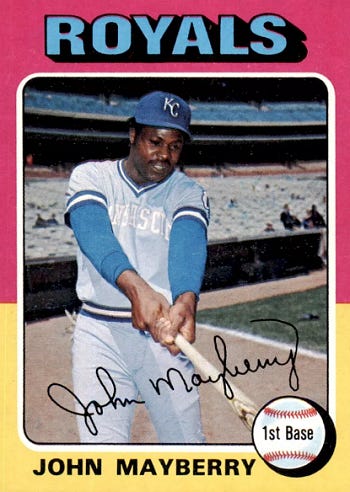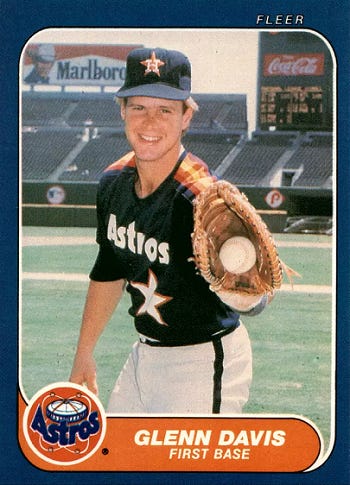Lonnie Smith turns 69 years old today. He was a fine player for more than 15 years, and would have had a strong case as National League MVP one year…if not for the putridity of his team.
But did you remember that Smith actually did finish as MVP runner-up one season? True story, and one that reminds me that there have been some surprising second-placers over the years. Or, at least surprising to me, looking back over the years.
Here are five of those almost-crowned MVPs, with their baseball cards from the years in question, naturally.
1975 Topps John Mayberry (#95)
Mayberry was already a two-time All-Star heading into 1975, and he had led the American League in walks and on-base percentage in 1973. He also snagged onto the Royals first-base job as soon as they dealt for him prior to 1972, and he hit 22 or more homers in each of his first three seasons in K.C.
But Mayberry took his game to a new level in 1975, smacking 34 home runs and driving in 106, both career highs. He also hit a robust .291 and posted 7.2 WAR — which of course no one knew anything about for another 40 years.
Red Sox rookie Fred Lynn skunked Mayberry in MVP voting, but the Royals’ star held off Jim Rice for second place. Mayberry would never come close to that kind of season again, though he did pop 30 long balls for Toronto in 1980.
He finished his career with 255 home runs and 879 RBI, but a .253 batting average and fewer than 1400 hits. A star-level career, but not one that kept his name in the limelight beyond one zero-vote Hall of Fame ballot in 1988.
1977 Topps Al Cowens (#262)
Two years after Mayberry’s big season, the Royals were the defending A.L. West champs, and Al Cowens was their incumbent rightfielder. In three years in the bigs, he had shown 20-steal speed, but not much else popped out from his stats — .260-.280, single-digit homer power, not many walks.
But as K.C. marched toward a 102-win season in 1977, Cowens found his lumber. That summer, he hit .312 with 21 home runs and 112 RBI while playing all 162 games. That fall, he picked up four first-place votes in the A.L. MVP ballot, losing out only to Rod Carew and his .388 batting average. Cowens also won his only Gold Glove.
His production fell off the table in 1978, his face got demolished by an Ed Farmer pitch early in 1979, and Cowens was gone from Kansas City by Opening Day in 1980.
He finally got most of his groove back in 1982, when he hit .270 with 20 long balls and 78 RBI for the Mariners. He played parts of four more seasons in Seattle, hitting at least 15 homers twice. But by 1986, it was clear Cowens would never climb that top rung in the MVP ladder.
1979 Topps Ken Singleton (#615)
By the time I started following baseball, Ken Singleton was an elder statesman of the game. My first memories of him, aside from pulling his cards from wax packs that summer, were watching him take his cuts against the White Sox and Phillies in the 1983 ALCS and World Series.
He didn’t do much damage in either matchup, but he did pick up an RBI for the Orioles in each round that October. And just Singleton’s presence in the first postseason I cared about was enough for me to pull his cards and dive into his stats.
I was impressed. And surprised.
Here was this guy I didn’t know much about, and yet he had hit .295 with 35 home runs and 111 RBI in 1979? And hit .300 or better four times? And drove in 100 or more three times?
Yeah, Singleton did all that. What I had no way to look up back then was that he finished second in American League MVP voting in 1979. I mean, I knew Don Baylor won the award, but Ken Singleton? Even with the world of stats available at our fingertips these days, I didn’t know he was the runner-up until, basically, now.
Not only that, but Singleton finished third in MVP voting in 1977, missing out to Carew and Cowens.
Singleton hit 24 homers in 1980 and hit .304, but then his production started to dwindle. That 1983 performance was a resurgence, but he tumbled to .215 with six homers and 36 RBI in 1984 and hung up his spikes at the end of the season.
1982 Topps Traded Lonnie Smith (#108T)
Smith is our man of the hour, and he was the man of the year for the 1982 Cardinals in a lot of ways…even if other players are better remembered from that championship team today.
You know, guys like Ozzie Smith, Bruce Sutter, Keith Hernandez, Joaquin Andujar, and Darrell Porter, MVP of both the National League Championship Series and World Series.
But it was Smith — Lonnie, that is — who led the Cards in hitting (.307), stolen bases (68), runs scored (120), and WAR (6.2) while holding down left field all season.
For his efforts, Skates garnered his only All-Star selection and eight first-place votes in National League MVP voting, finishing second behind Dale Murphy.
Funny thing was, Smith had spent the 1981 season with the Phillies (after helping them win the 1980 World Series) before a three-team trade that November brought him to St. Louis. That put him in burgundy on his 1982 base cards, but Topps gave him his redbird due in their 1982 Traded set, as you see above.
After that golden season in the shadow of the arch, Smith spent the mid-1980s putting up more average numbers. In a twist of baseball fate, he did end up helping the 1985 Royals take the World Series against his former team.
By the late 1980s, though, Smith was with the Braves, who were struggling to avoid losing 100 games a year. In 1989, when Atlanta finished 63-97-1, Smith broke out his big stick: .315, 21 home runs, 79 RBI, 25 steals, 89 runs scored, 8.8 WAR.
Alas, Atlanta’s bottom-dweller status doomed him to 11th in the NL MVP race. But, hey, at least he had those three World Series rings to keep him warm.
1986 Fleer Glenn Davis (#297)
After flashing 20-plus-homer power through multiple stops in the Astros’ minor league system, Glenn Davis got a cup of coffee with the big league club in September 1984. He popped two homers in 18 games but hit just .213, so the callup didn’t generate a lot of excitement around baseball.
Then, after starting the 1985 season with Triple-A Tucson, Davis was back in Houston by the middle of June. From that point through the end of the season, he hit .271 with 20 home runs and 64 RBI in an even 100 games. That power output as an Astros rookie was more or less a miracle, given the way the Astrodome ate potential home runs — a majors-low 47 balls left the yard there in 1984.
The Astros were an up-and-coming team, finishing 83-79 and in third place in the old National League West. It all came together for Houston and their upstart first baseman in 1986.
That summer, Davis hit .265 with 31 long balls and 101 RBI as the Astros cruised to a 10-game division win before losing the NLCS to the Mets in six games. For his troubles, Davis picked up six first-place votes in NL MVP balloting, losing out on the award to Mike Schmidt.
All along the way, collectors could revel in a full suite of Davis baseball cards, including the smiling, mustache-less Fleer dandy above.
Davis continued to mash for a few more seasons before injuries started to take their toll in his thirties. He was finished with All-Star-level performances and MVP votes by the time the 1990s rolled around, leaving us oldsters to wonder what might have been.
—
So, do you have a favorite MVP runner-up? Or, more on point, a most surprising MVP runner-up?
Without a doubt, my favorite number 2 was Dave Parker in 1985. And most surprising was probably Siggy Whamsley, second baseman and pitcher for the 1980 Podunk Plodders Little League team. Kid had the wheels of a Green Machine and a screwball with more movement than a Wham-O Super Ball. I’m still convinced Les Plunkster only won because he had some dirt on Coach.
Anyway, thanks for reading, and Merry Steve Christmas!
—Adam
Warmup Tosses
Our Baseball Cards Daily newsletter will be back live tomorrow. Get primed for the festivities by working through a couple of warmup tosses…









Kent Hrbek - 1984
Adam,
Google Willie Mays missing MVP’s for a great article on how even though Mays only finished second twice, he could twin “9” MVP’s.
So glad I saw his last road homer as a Giant in 1971!